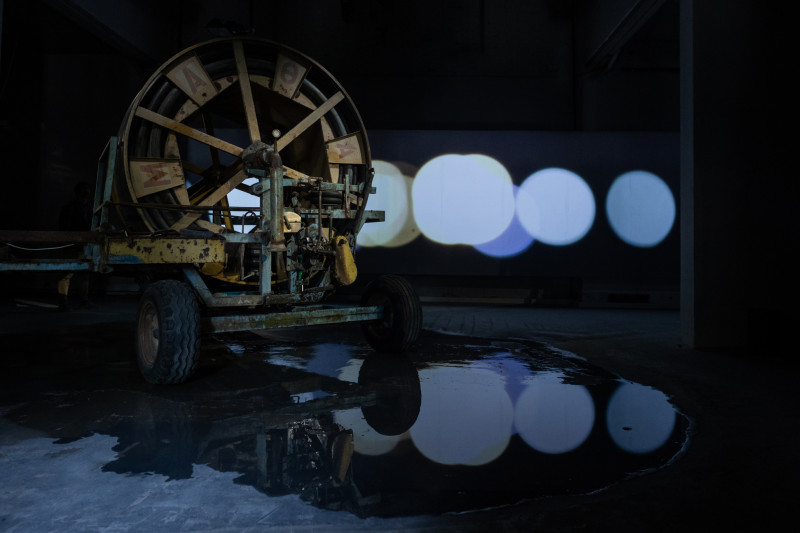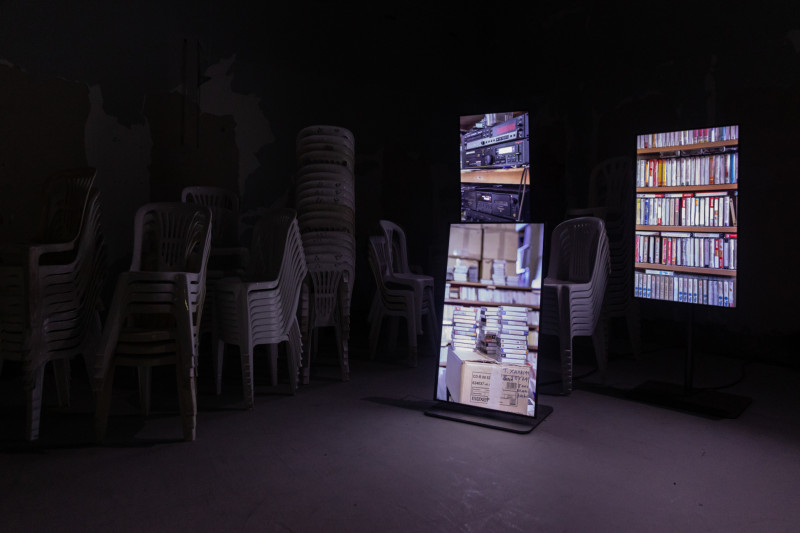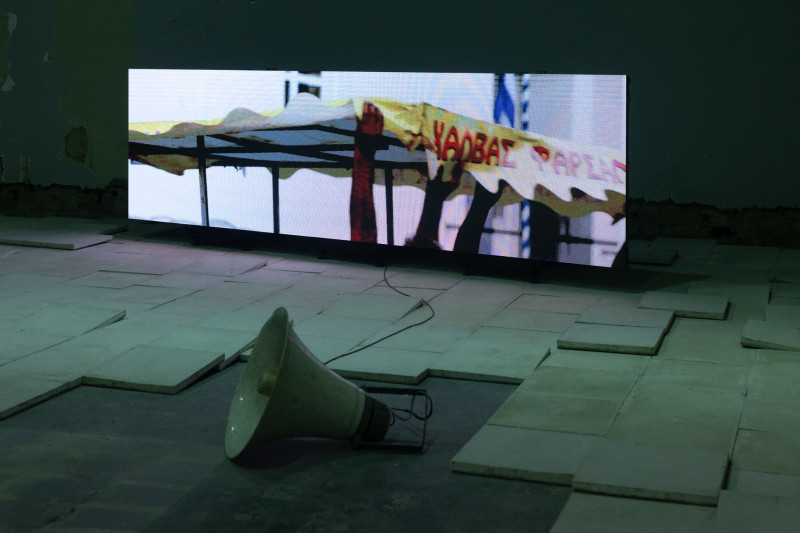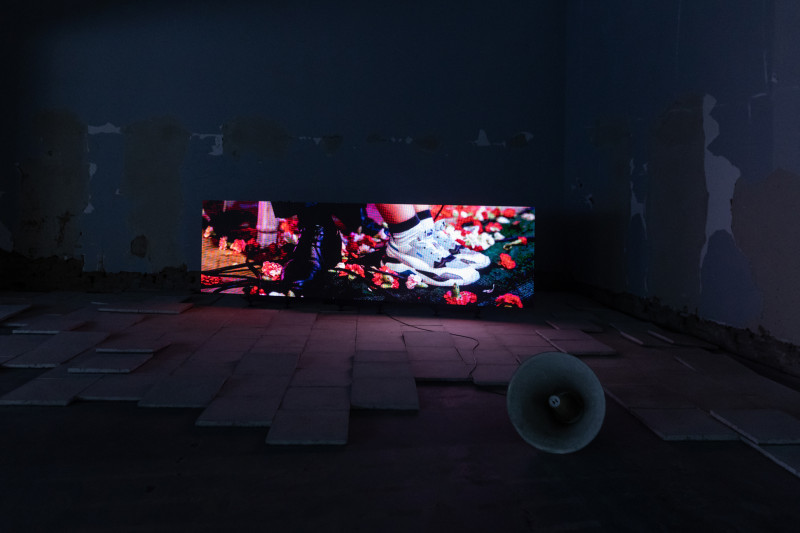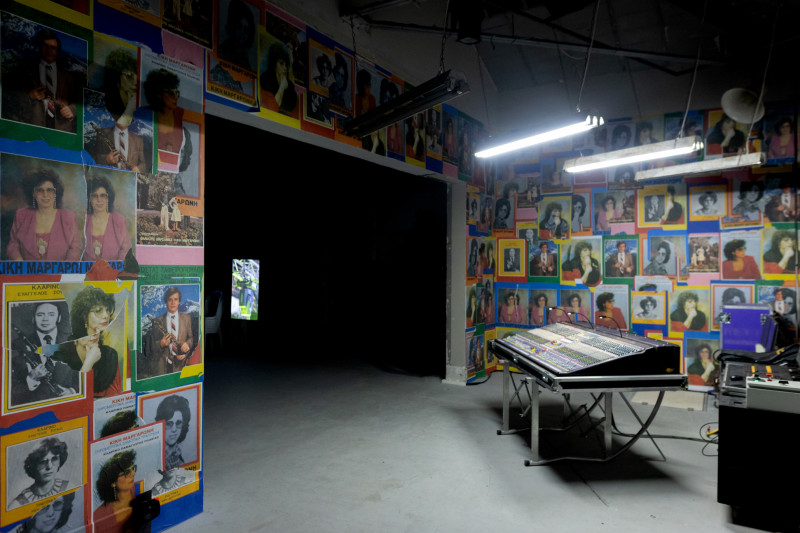The project “Dryland” was presented at the Greek pavilion at the 60th International Art Exhibition – La Biennale di Venezia, representing Greece in the event with Onassis Culture as the main supporter.
Objects, sounds, images: How is the human experience reflected in the ecosystem of the Greek festival? Queues are already forming at the Greek Pavilion in Venice’s famous Giardini for Dryland representing Greece at the 60th International Art Exhibition La Biennale di Venezia. It is an intermediary collective project, conceived by Thanasis Deligiannis and Yiannis Michalopoulos, with co-creators Elia Kalogiannis, Giorgos Kyvernitis, Kostas Haikalis and Fotis Sagonas. And in this 60th edition of the Biennale, as in the previous recent participations, Onassis Culture stands as a supporter of the Greek participation and the artists, as a key supporter. The implementation of the project and its exhibition in Venice has as its main funder the Ministry of Culture and as the National Commissioner, responsible for the organization, production and promotion of the project, the National Museum of Contemporary Art and curator of the Greek Pavilion Panos Giannikopoulos.
Pumping inspiration from the experience of the local festivals of mainland Greece, and more specifically of Thessaly but also of the wider area of Xiromero in Etoloakarnania, the project Xiromero/Dryland is a hybrid installation that proposes a visual investigation of the human experience within the ecosystem of the Greek festival, from the center of a provincial settlement to its outskirts agricultural landscape that surrounds it. Utilizing tools and through various artistic fields, a utilitarian watering machine is placed in the center of the Greek Pavilion, in the context of a spatial composition made up of video installations, sound environments, lighting bodies and the element of water.
The irrigation machine coordinates the sound, animation and lighting environment of the installation in real time. After two years of research at the Margaroni Residency, commissioned by Onassis Culture, the artistic team composed an installation that haunts you, as the condition and experience of the festival, this Greek celebration, ultimately reminds that people celebrate to remember but and to forget, through the 20-minute journey to Xiromeros/Dryland.
The sound of a bell welcoming the spectators to the venue, an agricultural irrigation machine in the center, video projections, televisions, led screens, dudukes, a sound console, white plastic chairs, posters of a great festival singer, testimonials about the festival printed on the wall. This is what the visitor faces at the Hellenic Pavilion, which is flooded with the sounds of bugles, farm car exhausts, marching motorcycles, festive songs and electronic music.
In the 20-minute loop of the projections, the viewer “visits” a festival where no one has ever gone a quarry and the mountains of Xiromeros, while seeing spinning chandeliers, festival lights, water jets, plastic toys, 3D spinning objects and vans with festival posters stuck on them. The water running from the sprinkler is reflected on the concrete and everything changes dimensions. And while the work draws its inspiration from rural culture and the way farmers organize and participate in the fair, with an irrigation machine in the center rotating and signaling all elements of the work to start and stop, creating counterpoints , is finally a work made with the logic of the dream.
The visitor is invited to reconstruct the world of the work, to decode the elements according to his own experience and to make his personal journey of joy and loss.
The artists report: “Between the festival, the underground clarinet, the field, the agricultural warehouse and the church are the lives, the voices and the imagination of the local musicians, but also of a whole world that goes along. There are of course those, men, but mainly women, who stopped being part of this constantly renewing world. Their centrifugal path is basically the one that defined the contours of our project. The substrate is the experience and memory of one of us, who as a child looks and listens to the celebration from afar at night and sometimes sits on the irrigation pipe while it unfolds in a field in the Thessalian plain.
With these thoughts and the primary desire to set in motion an open process of artistic research, we set out at the Margaroni Residency to explore the human experience of absence and presence in the ecosystem that creates the Greek festival. We traced the route from the center of a rural settlement to the edges of the agricultural landscape that surrounds it.
We started from the square, where the celebration is set up, on the slabs and cement, from the festival and its economy, the working musicians and farmers, the poster, the tape, the electricity, the sound amplification, the space, the food, the children, the tree, the rain, the field, the tractor, the water, the watering machine, the soil, the cotton, the absence of a woman.
In order to make this journey, several of us gathered, in the countryside, on the streets, in former industrial spaces, where we tested actions and materials, but also online, to discuss 3D models, since now all or some of the things that move us had to fit at the Greece stand in a way that leaves space free for the absence to speak.
At a distance from the aesthetic treatment of the objects that make up the installation – a gesture of unmediated performativity – the importance of the composition is emphasized: Inside a shell, externally similar to a church without a dome, which, having lost its internal iconography, now resembles a rural warehouse, where the machines exorcise the agony of national representations.
A shift between dominant and marginalized cultural object, which seems to create the in-between space of constructing new meanings. Guided by its sound and materiality, with Xiromero/Dryland we seek a multisensory experience, proposing an allegorical geography that hears the festival and sees the water.”
The curator of the Greek Pavilion, Panos Giannikopoulosnotes: “In Xiromero/Dryland pause and activation, center and periphery, action, reaction or inaction are framed by the active gaze of the viewer who is invited to help stitch together the juxtaposed material. The project is the result of teamwork. Artists question the limits of participation, hierarchies, the production context of a cultural product and its form, while trying to avoid a priori allocations of positions.
The grid concerning the distinction between mind and body, subject and object is disrupted, while sensory experience comes before its mental function. Artistic practice does not respond to clean classifications, thus deconstructing cultural fields and merging them. The high and the low, the artistic performance and the festival, the theater and the visual arts, the entertainment, the fiction and the recording, the mourning, all seem to come together. There is no imitation, but an escape from interpretation, while the cultural object is reconstructed and the body functions as a vehicle for being there and dealing with the functional everyday world, overriding explanatory theories and closed systems of reference: the dance remains open».
The implementation of the project and its exhibition in Venice has as its main financier the Ministry of Culture and as the National Commissioner, responsible for the organization, production and promotion of the project, the National Museum of Contemporary Art and the curator of the Hellenic Pavilion, Panos Giannikopoulos.
Working hours: Tuesday to Sunday: 11:00–19:00 (from 20 April to 30 September) & 10:00–18:00 (from 1 October to 24 November).
The 60th International Art Exhibition La Biennale di Venezia, titled Stranieri Ovunque – Strangers Everywhere, curated by Adriano Pedrosa, will be open to the public from April 20th to November 24th at the Giardini and Arsenale exhibition spaces. Discover more here.
Coefficients
A capture of Thanasis Deligiannis and Yannis Michalopoulos
Co-creators: Elia Kalogianni, George Governor, Kostas Haikalis, Fotis Sagonas
Artistic Partners: Fotini Papachristopoulou, Vasiliki-Maria Plavou, Marios Stamatis
Edited by Hellenic Pavilion: Panos Giannikopoulos
National Commissioner & Organization: EMST | National Museum of Contemporary Art, Athens
Lighting Design: Stefanos Drousiotis
Audiovisual installation designer and coordinator: Stavros Nikolakopoulos
Technical consultant for design of mechanisms and construction of special equipment: Manos Vordonarakis
Greek Pavilion opening performance: Natasha Tsakiridou (singer), Spyros Rakis Nikolaou (clarinet)
National Commissioner | Organization: EMST | National Museum of Modern Art
Head of Production of Greek Pavilion, EMST | National Museum of Modern Art: Yannis Arvanitis
Head of Communication & Press Office of Hellenic Pavilion, EMST | National Museum of Modern Art: Maria Tsolaki
Exhibition organization & production: Georgios Efstathoulides – Constructivist Exhibitions, Antonia Handzi
EMST | National Museum of Modern Art
Artistic Director: Katerina Gregou
Administrative & Financial Director: Athena Ioannou
read more
· Onassis Culture continuously supports the Greek participation in the International Art Exhibition La Biennale di Venezia. In recent years he supported the virtual reality film Oedipus in search of the Column by Loukia Alavanou (59th Venice Biennale), Mr. Stigl by Zafo Xagoraris, Eva Stefani and Panos Charalambous (58th Venice Biennale), Giorgos Drivas’ Dilemmas Workshop (57th Venice Biennale), Why Look At Animals? (Agriculture) by Maria Papadimitriou (56th Venice Biennale) et al.
· Stegi has collaborated again with Thanasis Deligiannis and Yiannis Michalopoulos on Ena Ena, a special musical journey to some provincial entertainment center of past decades. They were then commissioned as Onassis AiR Fellows to further research musical culture in the Greek region, with the Margaroni Residency. The artistic team launched, on the one hand, a retrospective of the life of a traditional singer and, on the other hand, a creative collection of multimedia material. They traveled to Xiromero and Thessaly, recorded, filmed and developed their research in various Onassis Culture sites for two whole years. A search that led to Xiromero/Dryland.
Credits Onassis Culture for the Margaroni Residency
Director of Culture: Aphrodite Panagiotakou | Deputy Director of Culture: Dimitris Theodoropoulos | Head of Onassis AiR Program: Misty Odor | Head of Production: Vassilis Panagiotakopoulos | Technical director: Lefteris Karapilas | Production Organization: Akis Hontasis | Production Execution: Dimitra Bouzani, Marianota Giannaki | Group Communication & Content Manager: Dimitris Drivas | Campaign Manager: Haris Giakoumakis
Read more about Dryland here
Read more about supporting Onassis Culture here
Read more about the art team’s research here
Photos: @Pinelopi Gerasimou
Source :Skai
I am Frederick Tuttle, who works in 247 News Agency as an author and mostly cover entertainment news. I have worked in this industry for 10 years and have gained a lot of experience. I am a very hard worker and always strive to get the best out of my work. I am also very passionate about my work and always try to keep up with the latest news and trends.


